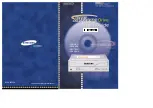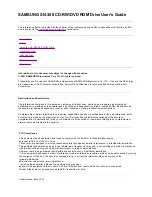
3.5 Bypass PCB Control Circuit
YASKAWA
TOEPYAIH6B01A HV600 AC Drive Narrow Bypass Installation & Startup
51
Table 3.10 I/O Switch Functions
Position
Switch
Function
Default Setting
A
DIP switch S1
RS-485 Terminating Resistor enables and disables the termination resistor of
these communications:
•
BACnet
•
APOGEE FLN
•
MEMOBUS/Modbus
•
Metasys N2
OFF
B
DIP switch S2
V/I switch for analog input.
V (voltage input)
I (current input)
◆
Wiring the Bypass Control Circuit Terminal
WARNING!
Electrical Shock Hazard. Do not remove covers or touch circuit boards while the bypass is energized. If you touch the
internal components of an energized bypass, it can cause serious injury or death.
NOTICE:
Do not let wire shields touch other signal lines or equipment. Insulate the wire shields with electrical tape or shrink tubing.
If you do not insulate the wire shields, it can cause a short circuit and damage the drive.
Note:
•
Isolate control circuit wiring from main circuit wiring and other high-power wiring. If the control circuit wires are adjacent to the main
circuit wires, electrical interference can cause the bypass or the devices around the bypass to malfunction.
•
Isolate TB1 contact output terminals from other control circuit wiring. If the output terminal wires are adjacent to other control circuit
wires, electrical interference can cause the bypass or devices around the bypass to malfunction.
•
Use a UL Listed Class 2 Power Supply to connect external power to the TB1 contact output control terminals. If the power supply for
peripheral devices is incorrect, it can cause a decrease in bypass performance.
•
Connect the shield of shielded cable to the applicable ground terminal. If the grounding is not correct, electrical interference can cause the
bypass or devices around the bypass to malfunction.
Correctly ground the bypass terminals and complete main circuit wiring before you wire the control circuit. Remove
the front cover.
1.
Refer to
and wire the control circuit.
WARNING!
Fire Hazard. Tighten all terminal screws to the correct tightening torque. Connections that are too loose or too
tight can cause incorrect operation and damage to the bypass. Incorrect connections can also cause death or serious
injury from fire.
Note:
• Use shielded wires and shielded twisted-pair wires for the control circuit terminal wiring. If the grounding is not correct, electrical
interference can cause the drive or devices around it to malfunction.
• Do not use control circuit wiring that is longer than 50 m (164 ft) to supply the frequency reference with an analog signal from a
remote source. Wiring that is too long can cause unsatisfactory system performance.
A - Loosen the screws and put the wire into the
opening on the terminal block.
B - Wire with a crimp ferrule attached, or use wire
that is not soldered with the core wires lightly
twisted.
C - Pull back the shielding and lightly twist the end
with your fingers to keep the ends from fraying.
D - If you do not use crimp ferrules, remove
approximately 5.5 mm (0.21 in) of the covering at
the end of the wire.
E - Blade width of 2.5 mm (0.1 in) or less
F - Blade depth of 0.4 mm (0.01 in) or less
Figure 3.9 Wiring Procedure for the Control Circuit
WARNING!
Fire Hazard. Tighten all terminal screws to the correct tightening torque. Connections that are too loose or too
tight can cause incorrect operation and damage to the bypass. Incorrect connections can also cause death or serious
injury from fire.
NOTICE:
Do not tin stranded wire with solder. Soldered wire connections can become loose over time and cause
unsatisfactory system performance.
















































